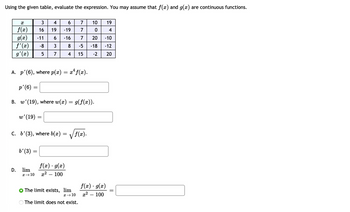Using the given table, evaluate the expression. You may assume that f(x) and g(x) are continuous functions. x 4 6 7 f(x) 16 19 -19 7 g(x) -11 6 -16 7 f'(x) -8 3 8 -5 g'(x) 5 7 4 15 A. p'(6), where p(x) = x^f(x). p'(6) B. w'(19), where w(x) = g(f(x)). w'(19) = D. 3 C. b'(3), where b(x) = √f(x). b'(3) = lim x-10 = f(x) · g(x) x² 100 10 19 0 4 20 -10 -18 -12 -2 20 O The limit exists, lim * 10 The limit does not exist. f(x) · g(x) x² 100 =
Using the given table, evaluate the expression. You may assume that f(x) and g(x) are continuous functions. x 4 6 7 f(x) 16 19 -19 7 g(x) -11 6 -16 7 f'(x) -8 3 8 -5 g'(x) 5 7 4 15 A. p'(6), where p(x) = x^f(x). p'(6) B. w'(19), where w(x) = g(f(x)). w'(19) = D. 3 C. b'(3), where b(x) = √f(x). b'(3) = lim x-10 = f(x) · g(x) x² 100 10 19 0 4 20 -10 -18 -12 -2 20 O The limit exists, lim * 10 The limit does not exist. f(x) · g(x) x² 100 =
Calculus For The Life Sciences
2nd Edition
ISBN:9780321964038
Author:GREENWELL, Raymond N., RITCHEY, Nathan P., Lial, Margaret L.
Publisher:GREENWELL, Raymond N., RITCHEY, Nathan P., Lial, Margaret L.
Chapter4: Calculating The Derivative
Section4.2: Derivatives Of Products And Quotients
Problem 35E
Related questions
Question

Transcribed Image Text:Using the given table, evaluate the expression. You may assume that f(x) and g(x) are continuous functions.
x
3
4
6
f(x)
16
19
-19
g(x) -11 6
-16
3
8
ƒ'(x) -8
g'(x) 5
7 4
A. p'(6), where p(x) = x¹ƒ(x).
p'(6)
B. w'(19), where w(x) = g(f(x)).
w' (19) =
=
=
D.
C. b’(3), where b(x) = √f(x).
b'(3)
=
10 19
0
4
20
-10
-5 -18 -12
15
-2
20
lim
x →10
f(x) g(x)
x² - 100
7|N
The limit exists, lim
x → 10
The limit does not exist.
f(x) · g(x)
x² - 100
Expert Solution
This question has been solved!
Explore an expertly crafted, step-by-step solution for a thorough understanding of key concepts.
This is a popular solution!
Trending now
This is a popular solution!
Step by step
Solved in 5 steps with 10 images

Follow-up Questions
Read through expert solutions to related follow-up questions below.
Follow-up Question
answer D

Transcribed Image Text:Using the given table, evaluate the expression. You may assume that f(x) and g(x) are continuous functions.
x
3
4
6
f(x)
16
19
-19
g(x) -11 6
-16
3
8
ƒ'(x) -8
g'(x) 5
7 4
A. p'(6), where p(x) = x¹ƒ(x).
p'(6)
B. w'(19), where w(x) = g(f(x)).
w' (19) =
=
=
D.
C. b’(3), where b(x) = √f(x).
b'(3)
=
10 19
0
4
20
-10
-5 -18 -12
15
-2
20
lim
x →10
f(x) g(x)
x² - 100
7|N
The limit exists, lim
x → 10
The limit does not exist.
f(x) · g(x)
x² - 100
Solution
Recommended textbooks for you

Calculus For The Life Sciences
Calculus
ISBN:
9780321964038
Author:
GREENWELL, Raymond N., RITCHEY, Nathan P., Lial, Margaret L.
Publisher:
Pearson Addison Wesley,

College Algebra
Algebra
ISBN:
9781305115545
Author:
James Stewart, Lothar Redlin, Saleem Watson
Publisher:
Cengage Learning

Calculus For The Life Sciences
Calculus
ISBN:
9780321964038
Author:
GREENWELL, Raymond N., RITCHEY, Nathan P., Lial, Margaret L.
Publisher:
Pearson Addison Wesley,

College Algebra
Algebra
ISBN:
9781305115545
Author:
James Stewart, Lothar Redlin, Saleem Watson
Publisher:
Cengage Learning